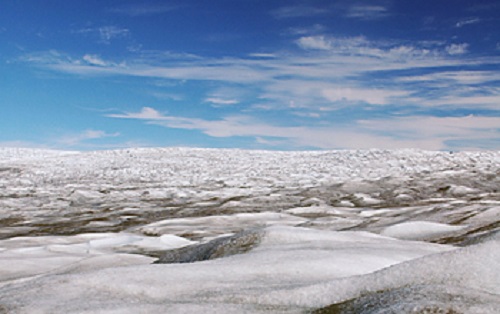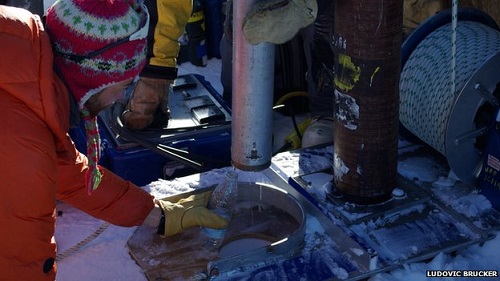Greenland ice sheet stores liquid water year-round
Posted on 27 December 2013 by John Hartz
This article is a reprint of a news relese posted by the National Science Foundation on Dec 23, 2013
Vast aquifer's potential for storing meltwater an important factor in calculating potential sea-level rise

Greenland Ice Sheet Credit: Photo by Peter West, NSF
National Science Foundation-funded researchers at the University of Utah have discovered a previously unknown aquifer in the Greenland ice sheet that holds liquid water all year long in the otherwise perpetually frozen winter landscape. The aquifer is extensive, covering 27,000 square miles.
The reservoir is known as the "perennial firn aquifer" because water persists within the firn--layers of snow and ice that don't melt for at least one season. Researchers believe it figures significantly in understanding the contribution of snowmelt and ice melt to rising sea levels.
The journal Nature Geoscience published the study online Sunday, Dec. 22.
"Of the current sea level rise, the Greenland Ice Sheet is the largest contributor--and it is melting at record levels,” said Rick Forster, the study's lead author and a professor of geography at the University of Utah. "So understanding the aquifer's capacity to store water from year to year is important because it fills a major gap in the overall equation of meltwater runoff and sea levels."
This research is the result of an international collaboration among researchers at the University of Utah; the Geological Survey of Denmark and Greenland; Byrd Polar Research Center at Ohio State University; the Institute for Marine and Atmospheric research Utrecht, Utrecht University in the Netherlands; the NASA Goddard Space Flight Center; the Center for Remote Sensing of Ice Sheets at the University of Kansas and the Desert Research Institute at the University of Nevada, Reno.
Forster and the Utah team were supported by both the Division of Polar Programs at the National Science Foundation and NASA.
Forster's team has been doing research in southeast Greenland since 2010 to measure snowfall accumulation and how it varies from year to year. The area they study covers 14 percent of southeast Greenland yet receives 32 percent of the entire ice sheet's snowfall, but there has been little data gathered.
In 2010, the team drilled core samples in three locations on the ice for analysis. Team members returned in 2011 to approximately the same area, but at lower elevation. Of the four core samples taken then, two came to the surface with liquid water pouring off the drill while the air temperatures were minus 4 degrees Fahrenheit. The water was found at about 33 feet below the surface at the first hole and at 82 feet in the second hole.

"This discovery was a surprise," Forster says. "Although water discharge from streams in winter had been previously reported, and snow temperature data implied small amounts of water, no one had yet reported observing water in the firn that had persisted through the winter."
The aquifer's 27,000 square miles is larger than the state of West Virginia. It is similar in form to a groundwater aquifer on land that can be used for drinking water.
"Here instead of the water being stored in the airspace between subsurface rock particles, the water is stored in the air space between the ice particles, like the juice in a snow cone," Forster said. "The surprising fact is the juice in this snow cone never freezes, even during the dark Greenland winter. Large amounts of snow fall on the surface late in the summer and quickly insulates the water from the subfreezing air temperatures above, allowing the water to persist all year long."
The Greenland ice sheet covers roughly the same area as the states of California, Nevada, Arizona, New Mexico, Colorado and Utah combined. The average thickness of the ice is 5,000 feet.
In 2012, the ice sheet lost volume of 60 cubic miles--a record for melt and runoff.
In the unlikely event that all the water retained in the ice sheet melted, it is estimated that the global sea level would rise about 21 feet, says Forster. Monitoring run-off amounts and how the water is moving is critical to accurately predicting sea-level changes.
Until now, calculations of the ice-sheet mass changes did not include a year-round storage mechanism for liquid water. Models predicted that water either flowed into rivers and lakes on the ice surface, into crevasses and subglacial streams that eventually run into the sea, or was refrozen within the ice sheet.
Discovery of the perennial aquifer will help scientists predict the movement and temperature of water within the ice sheet with more precision.
Forster says the reservoir's exact role is unknown. "It might conserve meltwater flow and thus help slow down the effects of climate change. But it may also have the opposite effect, providing lubrication to moving glaciers and exacerbating ice velocity and calving increasing the mass of ice loss to the global ocean."
As for whether climate change caused the aquifer to form, Forster says that's not clear, but simulations of the Greenland Ice Sheet going back to the early 1970s would suggest it has been around for some time.
The previously unknown storage mode was found in the Southeast section of Greenland, where conditions combine to provide sufficient rain and snowmelt to fill the firn with water, as well as high levels of snow accumulation that insulate the water from freezing during the winter.
The team used data collected by airborne and ground-penetrating radar to pinpoint the aquifer and then took core samples on the ground.
Airborne radar imagery was collected in the area by NASA Operation IceBridge, which is a program that collects images of Earth's polar ice in unprecedented detail to better understand the processes that connect polar regions with climate change. Ground-penetrating radar and a roving GPS navigation unit also were towed across the ice in the same area via snowmobile, collecting data every five seconds.
Researchers found that the radar images from air and ground corresponded, confirming that the airborne radar could map the aquifer just as well as the ground-based radar.
Core samples were taken with a 4-inch-diameter drill. Two segments were extracted that were saturated with liquid water--one from a depth of about 33 feet and another the following day about a mile east and at a depth of more than 80 feet.
Temperatures in the spring of 2011 were below average. Forster notes that, "because air temperatures were minus 4 degrees Fahrenheit during drilling and because surface melting in the area did not begin until June in 2011, there is no doubt that the water found in the firn had persisted through the winter."
Subject paper:
Extensive liquid meltwater storage in firn within the Greenland ice sheet, Richard R. Forster, Jason E. Box, Michiel R. van den Broeke, Clément Miège, Evan W. Burgess, Jan H. van Angelen, Jan T. M. Lenaerts, Lora S. Koenig, John Paden, Cameron Lewis, S. Prasad Gogineni, Carl Leuschen & Joseph R. McConnell, Nature Geoscience (2013) doi:10.1038/ngeo2043
Received 21 June 2013: Accepted 21 November 2013: Published online 22 December 2013































 Arguments
Arguments






























This is interesting science, but I don't see what the hubbub is with regard to sea level. The entire estimated annual melt of Greenland amounts to a fraction of a millimeter of sea level as does the entire content of the newly found aquifer.
Thanks for this. Just shows how little we know about the systems we are in the process of destroying.
And this is in an area that you can walk across and get direct access to, yet we are still finding out things about its structure that are entirely unexpected and counter-intuitive.
How certain, then, can we be that we know enough about the structure of the subsea permafrost and methane hydrate to say for certain that sudden off-gassing of significant quantities of methane could not happen? Just sayin'. ;-/
Speaking of sudden release, is there any chance that these fresh (I assume) waters could relatively suddenly be released into the Northern Atlantic and therefore potentially shut down or greatly slow down the Atlantic Meridional Overturning Current? How much water over how much time would be needed. IIRC it was in the range of .1 to1 Sverdrup (=.1 to 1million meters ^3 per second)?
tcflood@1,
I think Forster et al 2013 is talking about SLR potential in case of a sudden release of waters from the aquafier like this. At 27,000 sqare miles, it is just ~ few times smaller than lake Agassiz.
We know from paleo that SLR due to icesheet melt is a non-linear process, punctuated by sudden rises, for example the release of lake Agassiz is thought to contribute 1-3m of SLR during 8,200 yr climate event. This may also account for various flood myths of prehistoric cultures, including the Biblical flood myth.
The aquafier just discovered may not be the only one existing within the GIS or AIS. Understanding their properties and the mechanisms of their release may hold a clue to the understanding the non-linearities of icesheet contribution to SLR.
Tcflood,
Since this aquifer has just been discovered its importance may not yet be known. However, it is well known that the area of melting ice is rapidly expanding upward on Greenland. Part of the area of the aquifer likely was too cold to retain liquid water in the past. How much? It takes a lot of energy to raise the previously cold ice to the melting point (if liquid water exists the ice has been raised to the melting point). This could result in much more melting in the future as the warm ice melts and the aquifer, now full, flows into the sea. We will have to wait a few years to learn more about the possible importance of this discovery.
A few mm here and a few mm there and pretty soon it looks like real sea level rise.
Water is curious, in that it can exist in solid and liquid forms at ~ the same temperature. Who'd have thought liquid water lurked beneath the Greenland snows? Not me. It seems counterintuitive, until the insulating property of a snow blanket is explained. What a fascinating world: let's hope we don't wreck it too soon.
If we were to calculate the amount of ice that could melt due to either incoming radiation or a walker cell, linking the warming ocean with the Greenland ice sheet, we would come up with a certain amount based on the latent heat of ice as it converts to water. However, with all this water already melted, the melt of ice only has to breach this aquafer to release much of this water. By the by, I thought that the whole of Greenland would have to melt to raise sea level 20 feet. Am I misreading or does this article suggest that just this amount of fern water, if released, would raise sea level 21 feet.
@william at 04:38 AM on 29 December, 2013
No, the amount of melted water would contribute only a very small rise globally.
21 feet would be for the melting of the entire Greenland ice sheet.
"In the unlikely event that all the water retained in the ice sheet melted, it is estimated that the global sea level would rise about 21 feet"